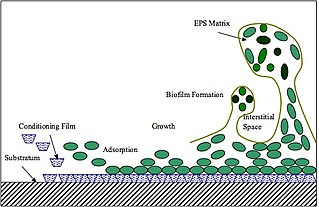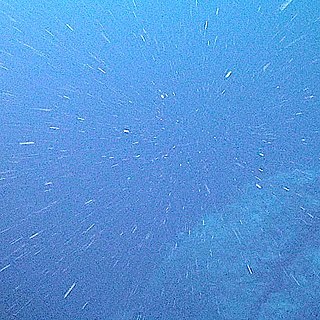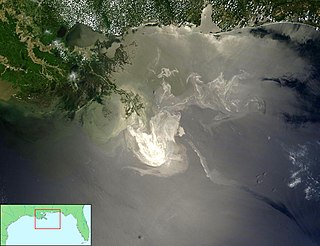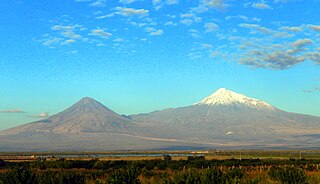
The Black Sea is a marginal sea of the Atlantic Ocean lying between Europe and Asia; east of the Balkans, south of the East European Plain in Eastern Europe, west of the Caucasus, and north of Anatolia in Western Asia. It is supplied by major rivers, principally the Danube, Dnieper, and Don. The watersheds of many countries drain into the sea beyond the six that share its coast.

The Bosporus or Bosphorus, also known as the Strait of Istanbul, is a narrow, natural strait and an internationally significant waterway located in northwestern Turkey. It forms part of the continental boundary between Europe and Asia, and divides Turkey by separating Anatolia from Thrace. It is the world's narrowest strait used for international navigation. The Bosporus connects the Black Sea with the Sea of Marmara, and, by extension via the Dardanelles, the Aegean and Mediterranean seas, and by the Kerch Strait, the sea of Azov.

The Mediterranean Sea is a sea connected to the Atlantic Ocean, surrounded by the Mediterranean Basin and almost completely enclosed by land: on the north by Western and Southern Europe and Anatolia, on the south by North Africa, and on the east by the Levant. The Sea has played a central role in the history of Western civilization. Although the Mediterranean is sometimes considered a part of the Atlantic Ocean, it is usually referred to as a separate body of water. Geological evidence indicates that around 5.9 million years ago, the Mediterranean was cut off from the Atlantic and was partly or completely desiccated over a period of some 600,000 years during the Messinian salinity crisis before being refilled by the Zanclean flood about 5.3 million years ago.

Plankton are the diverse collection of organisms found in water that are unable to propel themselves against a current. The individual organisms constituting plankton are called plankters. In the ocean, they provide a crucial source of food to many small and large aquatic organisms, such as bivalves, fish and whales.

Loricifera is a phylum of very small to microscopic marine cycloneuralian sediment-dwelling animals that had been determined to be 37 described species, in nine genera, but in 2021 has increased to 43 species. Aside from these described species, there are approximately 100 more that have been collected and not yet described. Their sizes range from 100 μm to ca. 1 mm. They are characterised by a protective outer case called a lorica and their habitat is in the spaces between marine gravel to which they attach themselves. The phylum was discovered in 1983 by Reinhardt Kristensen, near Roscoff, France. They are among the most recently discovered groups of Metazoans. They attach themselves quite firmly to the substrate, and hence remained undiscovered for so long. The first specimen was collected in the 1970s, and later described in 1983. They are found at all depths, in different sediment types, and in all latitudes.

An oil spill is the release of a liquid petroleum hydrocarbon into the environment, especially the marine ecosystem, due to human activity, and is a form of pollution. The term is usually given to marine oil spills, where oil is released into the ocean or coastal waters, but spills may also occur on land. Oil spills may be due to releases of crude oil from tankers, offshore platforms, drilling rigs and wells, as well as spills of refined petroleum products and their by-products, heavier fuels used by large ships such as bunker fuel, or the spill of any oily refuse or waste oil.

Taksim Square, situated in Beyoğlu in the European part of Istanbul, Turkey, is a major tourist and leisure district famed for its restaurants, shops, and hotels. It is considered the heart of modern Istanbul, with the central station of the Istanbul Metro network. Taksim Square is also the location of the Republic Monument which was crafted by Pietro Canonica and inaugurated in 1928. The monument commemorates the 5th anniversary of the foundation of the Republic of Turkey in 1923, following the Turkish War of Independence.

Istanbul is the largest city in Turkey and the country's economic, cultural and historic center. The city straddles the Bosphorus strait, and lies in both Europe and Asia, with a population of over 15 million residents, comprising 19% of the population of Turkey. Istanbul is the most populous city in Europe, and the world's fifteenth-largest city.

Cotylorhiza is a genus of true jellyfish from the family Cepheidae. The genus is found in the central-east Atlantic, Mediterranean, and western Indian Ocean.

Ocean Alliance, Inc., a 501(c)3 organization, is dedicated to the conservation of whales and their marine environment through research and education. The organization is based in the iconic Tarr & Wonson Paint Manufactory in Gloucester, Massachusetts, United States.

Extracellular polymeric substances (EPSs) are natural polymers of high molecular weight secreted by microorganisms into their environment. EPSs establish the functional and structural integrity of biofilms, and are considered the fundamental component that determines the physiochemical properties of a biofilm.

In the deep ocean, marine snow is a continuous shower of mostly organic detritus falling from the upper layers of the water column. It is a significant means of exporting energy from the light-rich photic zone to the aphotic zone below, which is referred to as the biological pump. Export production is the amount of organic matter produced in the ocean by primary production that is not recycled (remineralised) before it sinks into the aphotic zone. Because of the role of export production in the ocean's biological pump, it is typically measured in units of carbon. The term was first coined by the explorer William Beebe as he observed it from his bathysphere. As the origin of marine snow lies in activities within the productive photic zone, the prevalence of marine snow changes with seasonal fluctuations in photosynthetic activity and ocean currents. Marine snow can be an important food source for organisms living in the aphotic zone, particularly for organisms which live very deep in the water column.

MV Mavi Marmara is a Comoros-flagged passenger ship, which was formerly owned and operated by İDO Istanbul Fast Ferries Co. Inc. on the line Sarayburnu, Istanbul-Marmara Island-Avşa Island in the Sea of Marmara. Built at the Golden Gate Shipyard by Turkish Shipbuilding Co. in 1994, the ship has a capacity of 1,080 passengers. It is best known for its participation in the Gaza Freedom Flotilla and the deadly confrontation that took place on it during the Gaza flotilla raid.
The wildlife of Turkey is abundant and very varied. Turkey is a large country with many geographic and climatic regions and a great diversity of plants and animals, each suited to its own particular habitat. About 1500 species of vertebrates have been recorded in the country and around 19,000 species of invertebrate. There are about 11,000 species of flowering plants; some of the world's staple crops were first cultivated in this area, and many of their wild relatives are still found here. The country acts as a cross roads with links to Europe, Asia and the Near East, and many birds use the country as a staging post during migration.

The Istanbul Canal is a project for the artificial sea-level waterway, which is planned by Turkey on East Thrace, connecting the Black Sea to the Sea of Marmara, and thus to the Aegean and Mediterranean seas. Istanbul Canal would bisect the current European side of Istanbul and thus form an island between Asia and Europe. The new waterway would bypass the current Bosporus.

The 2010 Deepwater Horizon oil spill in the Gulf of Mexico has been described as the worst environmental disaster in the United States, releasing about 4.9 million barrels of crude oil making it the largest marine oil spill. Both the spill and the cleanup efforts had effects on the environment.

Climate changeinTurkey includes changes in the climate of Turkey, their effects and how the country is adapting to those changes. Turkey's annual and maximum temperatures are rising, and 2020 was the third hottest year on record. Turkey will be greatly affected by climate change, and is already experiencing more extreme weather, with droughts and heatwaves being the main hazards. Current greenhouse gas emissions by Turkey are about 1% of the global total, and energy policy includes heavily subsidizing coal in Turkey. Turkey is one of the few countries that have not ratified the Paris Agreement, so is not one of the parties to the Paris Agreement. The Environment Ministry co-ordinates adaptation to climate change, and adaptation has been planned for water resources by river basin, and for agriculture.
Yavuz, ex Deepsea Metro I, is a Turkey-flagged ultra deepwater drillship owned and operated by the state-owned Turkish Petroleum Corporation (TPAO). She is Turkey's second drillship.

Kanuni is a Turkey-flagged sixth-generation ultra deepwater drillship owned and operated by the Turkish Petroleum Corporation. She is Turkey's third drillship.

Drought is common in Turkey, especially in the south and center of the country, with the most recent occurring in 2020. Drought events are forecast to occur more frequently due to climate change. Most water loss is due to poor irrigation.


















